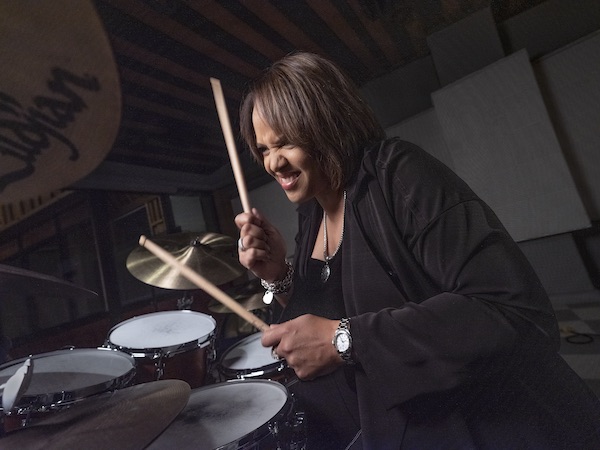Oct 28, 2025 10:47 AM
In Memoriam: Jack DeJohnette, 1942–2025
Jack DeJohnette, a bold and resourceful drummer and NEA Jazz Master who forged a unique vocabulary on the kit over his…

Terri Lyne Carrington, seen here in New York at Power Station at BerkleeNYC, is the first female instrumentalist to top the Jazz Artist category in the DownBeat Critics Poll.
(Photo: Jimmy & Dena Jatz)She asked Stevens, who, like Mitchell, is a native Canadian, to write an arrangement. “Being a collaborative process, I had some ideas,” the guitarist said. “Rather than have a specific mood imbue the music, the music imbues a specific mood that can change depending on the day or time.”
In deference to Mitchell’s precedent, the mood is subdued, with Parks’ Rhodes piano a floating presence atop a colloquy between Ray’s sung vocals and Overall’s spoken-word performance.
As he wrote, Overall said he attempted to tailor his words to those of Mitchell, who granted permission for the band to alter the piece. Carrington steered him from a theme of romantic love toward one of divine love, which comports with the biblical allusions in Mitchell’s lyrics. Ultimately, Overall drew heavily on The Greatest Salesman in the World, Og Mandino’s 1968 book based on Christian philosophy. Overall’s final line, “I will greet this day with love in my heart,” is lifted almost verbatim from the book.
Though lyrics fill Disc 1—only “Over And Sons,” by Stevens, is an instrumental (save for wordless embellishments courtesy of Ray)—they are absent from the long improvised piece on Disc 2, which, after the session, was divided into four tracks, each titled “Dreams And Desperate Measures.” The improvisation was conceived as a kind of “B-side,” Carrington said, recalling that, to facilitate the creative flow, the studio lights were turned off before the musicians played.
“I was determined to do this in one take,” she said. “We were committed to whatever happens.”
The result was a long and winding journey with enough elasticity to complement the click-track precision of the first disc. Featuring seductive interplay among Carrington, Parks and Stevens—and anchored, on acoustic bass, by Esperanza Spalding, who, along with Carrington and pianist Allen, constituted one of the most memorable trios of recent years—the basic track was later augmented with Guerin’s saxophone and electric bass. Winds and strings, also added later, tie it all together in a tightly woven orchestration by Edmar Colón.
No such bonding agent was applied to Social Science’s May 23 improvisation, livestreamed by the Vermont Jazz Center. The risky plan, which called for the band members to play together in real-time from their respective homes—two each in New York state and Massachusetts, one from Washington state and one from Canada—came off without a technical hitch.
A particular challenge of this unstructured improvisation—in a post-performance email, Carrington asserted that there were no preplanned musical markers to guide the players—was the inability of the musicians to hear their fellow bandmates in a latency-free environment. This yielded an exploratory exercise in which grooves were comparatively rare, noticeably more hesitant—and clearly more impactful when found.
Having experimented with remote collective improvisation a few times before the Vermont webcast, the band members, in the days before the event, were realistic about how the process would play out, even as they sought to embrace its possibilities. “We’re not trying to play in time with each other,” Carrington said. “We’re responding to what’s being heard.”
And what did Carrington actually experience in the webcast improv? In a short debriefing immediately after the performance, she told Eugene Uman, the Vermont Jazz Center director, that she “felt like we were walking on unstable ground.”
A few hours later, however, she was focusing on a positive side to the improvisation, which followed videos of tunes from Waiting Game pre-recorded at the musicians’ homes and compiled in a flurry of back-and-forth communication in the run-up to the webcast.
Asked in a post-performance email correspondence whether she felt any special emotion knowing that the band had been compelled by circumstance to execute the material in this way, Carrington answered in the affirmative.
The reason? “We would never have played with latency in the past, in separate locations,” she wrote. “It spoke to the desire to come together musically and offer something, no matter how humble. It’s the determination to be fearless. Speaks to how we are all feeling now as well.”
Carrington said that, no matter how unsettling the pandemic and the protests, she was duty-bound to forge ahead creatively. In addition to developing new music for Social Science, she is programming shows at Detroit’s Carr Center, where she is artistic director. Come September, she ventured, the shows will go on—albeit with smaller crowds and social-distancing measures for both the spectators and the musicians.
“I’m trying to come out of that traumatic headspace and get back to self-care and music,” she said.
At Berklee, administrators are planning to have both online and on-site classes in the fall. Carrington expressed excitement about the faculty addition of pianist Kris Davis, an acclaimed composer and improviser, who will serve as associate program director of creative development for the Berklee Institute of Jazz and Gender Justice.
Meanwhile, Carrington is keeping Allen’s legacy alive—developing a Geri Allen reading room at Berklee and playing the pianist’s music, which will be part of a residency she has scheduled at San Francisco’s SFJAZZ Center in 2021. Carrington has written about Allen’s music in the journal Jazz and Culture, and is including the pianist’s work in a forthcoming book devoted to female composers. All these projects re-
inforce her efforts to establish equity for women in jazz—and, by extension, for people of color in the world at large.
“We will continue,” she wrote in a June statement issued through the Berklee institute, “to educate with gender justice and racial justice as guiding principles.” DB
This story originally was published in the August 2020 issue of DownBeat. Subscribe here.

Jack DeJohnette boasted a musical resume that was as long as it was fearsome.
Oct 28, 2025 10:47 AM
Jack DeJohnette, a bold and resourceful drummer and NEA Jazz Master who forged a unique vocabulary on the kit over his…

D’Angelo achieved commercial and critical success experimenting with a fusion of jazz, funk, soul, R&B and hip-hop.
Oct 14, 2025 1:47 PM
D’Angelo, a Grammy-winning R&B and neo-soul singer, guitarist and pianist who exerted a profound influence on 21st…

To see the complete list of nominations for the 2026 Grammy Awards, go to grammy.com.
Nov 11, 2025 12:35 PM
The nominations for the 2026 Grammy Awards are in, with plenty to smile about for the worlds of jazz, blues and beyond.…

Jim McNeely’s singular body of work had a profound and lasting influence on many of today’s top jazz composers in the U.S. and in Europe.
Oct 7, 2025 3:40 PM
Pianist Jim McNeely, one of the most distinguished large ensemble jazz composers of his generation, died Sept. 26 at…

Drummond was cherished by generations of mainstream jazz listeners and bandleaders for his authoritative tonal presence, a defining quality of his style most apparent when he played his instrument unamplified.
Nov 4, 2025 11:39 AM
Ray Drummond, a first-call bassist who appeared on hundreds of albums as a sideman for some of the top names in jazz…






